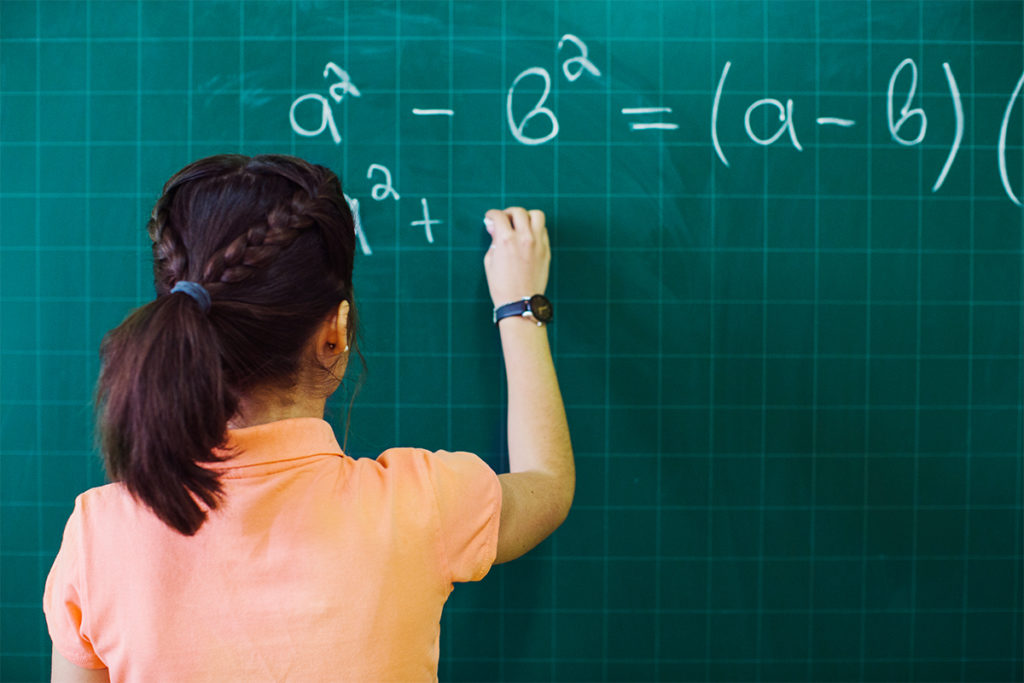As we described in an earlier post, we are conducting a systematic review to explore how improving girls’ math identity supports their participation, engagement and achievement in math. So far, we have screened more than 7,000 articles for possible inclusion and are beginning to code those meeting the inclusion criteria. As we read through full texts of studies to code them for the review, a few stand out. One of these, “A portrait of a feminist mathematics classroom: What adolescent girls say about mathematics, themselves, and their experiences in a ‘unique’ learning environment,” by Dawn Leigh Anderson (2005) grabbed our attention because of “feminist mathematics” in the title. As we read it, we found that Anderson identifies and characterizes themes in her research that will be central to the analysis in our systematic review. Here we summarize her research and present those themes.
In her case study, Anderson sets out to answer the following questions: what are the experiences of girls in a feminist mathematics class, what are their perceptions of themselves as learners, and what are their perceptions of math. She defines feminist mathematics as a math experience that values female voices in the classroom and that considers and connects to female experiences. She explains that the purpose of feminist mathematics is not to draw comparisons or to denigrate alternate instructional approaches, but to validate place for female voices in mathematics, one that values them as doers of mathematics.
The program
Anderson evaluates a program called SummerMath, an intensive four-week summer math program for high school girls. The program recruits high school girls who may or may not be engaged in math learning, who may or may not be successful in the math classroom, and who may or may not want to be there.
The goal of the program is to take a feminist approach. Girls are expected to struggle (it is perceived as part of the process of learning) as they create meaning in math. An expert team – who have had professional development on gender equity issues related to teaching – provides a support network for investigations in math. The program is curriculum-based and supports the girls using a pair/team/collaborative approach. The program encourages the girls to own the process, to solve problems that have meaning for them, and to focus not on the “right answer” but to create meaning from the endeavor.
Methods
Anderson presents her study findings in eight basic themes. Here we highlight direct insights aligned to our own study of girls’ math identity. In particular, we highlight the following three themes: the use of constructivist learning techniques, the role of the instructor in the classroom, and the use of feminist mathematics as a potential strategy to foster the development of math identity in girls.
Constructivist learning techniques
In the included studies in our systematic review, constructivist learning techniques is a recurring theme for the development of girls’ math identity. Anderson discusses this in the terms of agency and authorship. Agency is the process by which the learner acts on her own behalf to learn math, and authorship refers to what and how math learning is valued. Given SummerMath’s feminist mathematics approach, girls were required to choose their own path to learning and solving problems on their own or in groups. Through this process girls were provided an opportunity to work together to test ideas, formulate multiple solutions, and participate in a team approach. These collaborations gave students time to exchange ideas, see multiple ways of solving problems, and to depend on themselves.
However, the interplay between agency and authorship was not without issues. Girls had to be present in the moment. They could not fade into the background, relinquish participation, or be anonymous in the classroom. Additionally, increased authorship meant that the girls experienced limited agency, increased anxiety, and frustration as they struggled with authorship. Ultimately, participants viewed these costs as a necessary discomfort as they lead to full authorship of a solution and increased efficacy.
The role of the instructor
Anderson also highlights the importance of redefining power relations within a feminist approach to mathematics. The educators in the SummerMath program redefined their power and became guides in the process instead of instructors. Their role was not to impart knowledge, but to guide the girls as they took power to construct their own knowledge. Participants had power in that they controlled how they learned and how much they learned. In this way the student-teacher relationship was built on cooperation and encouragement and demonstrated to students that they were valued and respected. The role of the math educator is not the holder of a pocket of information that is transferred to the girl. For example, while participants felt that the teachers never taught math, they still learned a great deal of math. Through this experience, participants came to see their math teacher as someone who “guides learning and promotes exploration and free expression of mathematical ideas.”
Use of feminist mathematics
Finally, Anderson describes student perceptions of using a feminist approach to mathematics teaching. The participants in this study saw that they now had a different relationship to mathematics. Again, they had a sense of authorship, of agency, and of playing a different role in this classroom than in a traditional classroom. Not all of the girls were happy with the change and questioned the effectiveness or plausibility of it happening in their regular classrooms. While this approach caused the girls to work harder as “authors, agents, and collaborators,” their perception, and perhaps the reality, is that this approach would not prepare students for standardized tests (on which traditional approaches focus). Six of the seven participants reported not wanting to use a feminist approach in their regular math classrooms, reporting that the differences in approaches were large, would be difficult to implement in a regular classroom, and would be too much work.
Moreover, some girls in this study did not like the feminist approach. Initial resistance stemmed from student’s traditional views of teaching and learning, for example, finding answers rather than solutions to math problems. For several participants, continued resistance stemmed from a desire to be told if they were right or wrong or had found the answer. They didn’t enjoy the struggle associated with authorship and instead preferred a traditional classroom that required less engagement.
Photo credit: Freepik



